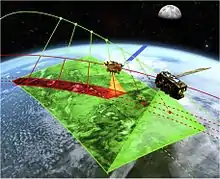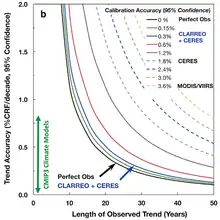CLARREO
CLARREO (Climate Absolute Radiance and Refractivity Observatory) is a high-priority NASA decadal survey mission, originally selected as such by the National Research Council in 2007.[1] The CLARREO mission is intended to provide a metrology laboratory in orbit to accurately quantify and attribute Earth's climate change (see List of climate research satellites). The mission is also designed to transfer its high accuracy to other spaceborne sensors. It would serve as a reference calibration standard in orbit,[2] making climate trends apparent in their data sets within a 30-year time frame.[3] These measurements may go on to enable testing, validation, and improvement of climate model prediction.
.jpg.webp)
Due to funding cuts in announced for the 2012 budget, the CLARREO mission was significantly scaled back, while remaining spaceborne projects were eyed to fill the gap.[4]
In the President's FY16 budget request, a smaller CLARREO Pathfinder (CPF) mission was provided $76.9M to demonstrate essential measurement technologies of the CLARREO Tier 1 Decadal Survey mission.[5] That funding will potentially support the flight of the Reflected Solar (RS) spectrometer, which is one piece of the full Decadal Survey-recommended mission, hosted on the International Space Station (ISS) in 2020[6] (although the Trump administration's budget proposal of March 2017 appears set to defund this mission[7]).
The CLARREO mission concept
Below is the mission concept presented at the Mission Concept Review in November 2010.[8] CLARREO was then envisioned to consist of four observatories on two dual-manifested launches on Minotaur IV+ vehicles.
- Three Instruments (two of each)
- Infrared (IR) Spectrometer
- Reflected Solar (RS) Spectrometer
- Global Navigation Satellite System-Radio Occultation (GNSS-RO)
- Four Observatories, two dual-manifested launches on Minotaur IV+ vehicles
- July 2018: Two infrared observatories, each with GNSS-RO
- May 2020: Two reflected solar observatories
- 609 km polar orbits (90 degree inclination)
Alternative mission concepts were developed to accommodate reduced available funding. A CLARREO mission on the International Space Station, to include one each of the RS and IR spectrometers, was found to provide the best science value for the lowest feasible cost. Due to the ISS orbital inclination of 51.65 degrees, CLARREO on ISS measurements would not include the polar regions, resulting in the mission being unable to track global spectral benchmarks compared to the version of the mission presented at the Mission Concept Review.[9]
Pathfinder mission concept
In 2016, a Pathfinder mission to the full CLARREO mission received funding. "The allocated funds support the flight of a Reflected Solar (RS) spectrometer, hosted on the International Space Station (ISS) in the 2020 time frame. ... The CPF is a Class D mission with 1 year of operations on orbit and 1 year for analysis of acquired data." The mission is designed to demonstrate essential measurement technologies in orbit that can be used to reduce the risk of a full CLARREO mission. CLARREO Pathfinder has two primary objectives: to demonstrate high accuracy on orbit traceable to International Systems of Units (SI) and to transfer that accuracy to other spaceborne sensors.[10] Pathfinders threshold objective compared to the full baseline CLARREO mission is relaxed by a factor of two from 0.15% to 0.3% (k=1).[11]
The science behind CLARREO
CLARREO could make highly accurate decadal change observations that are traceable to International Systems of Units (SI) standards. For example, at solar wavelengths this is intended to be confirmed after launch using comparison of actual data to theoretical simulations of lunar/solar radiance generated within a high-fidelity sensor model,[12] although it is unclear how such a non-experimental approach will ensure SI traceability. The Earth observations then made by CLARREO have sensitivity to the most critical but least understood climate radiative forcings, responses, and feedbacks, such as:
- Infrared spectra to infer temperature and water vapor feedbacks, cloud feedbacks, and decadal change of temperature profiles, water vapor profiles, clouds, and greenhouse gas radiative effects
- GNSS-RO to infer decadal change of temperature profiles
- Solar reflected spectra to infer cloud feedbacks, snow/ice albedo feedbacks, and decadal change of clouds, radiative fluxes, aerosols, snow cover, sea ice, and land use[13]
Reference intercalibration

Current satellite-based sensors are not designed to meet the accuracy requirements needed for climate change detection. Many sensors used for climate measurements were designed to meet operational weather needs and are not optimized for climate sampling. These sensors, along with older instruments designed for climate, lack the on-board ability to test for systematic errors on orbit. The CLARREO mission will meet these goals through careful consideration of the instrument design, calibration traceability at all stages of development and operation, with spectral, spatial and temporal sampling focused specifically on the creation of climate records.[15] Then after development of new cross-calibration methodologies[14] far more accurate than those achieved today,[16] CLARREO may serve as an in-orbit standard to provide reference intercalibration for missions like the broadband Clouds and the Earth's Radiant Energy System (CERES), operational sounders including the Cross-track Infrared Sounder (CrIS) and Infrared Atmospheric Sounding Interferometer (IASI), and imagers such as the Visible Infrared Imaging Radiometer Suite (VIIRS) and Advanced Very High Resolution Radiometer (AVHRR).[17]
CLARREO selection
The 2007 National Research Council (NRC) Decadal Survey report,[1] "Earth Science and Applications from Space: National Imperatives for the Next Decade and Beyond," provides the basis for the future direction of NASA's space-based Earth observation system. Missions were ranked according to scientific merit, contributions to long-term observational records, societal benefits, affordability, and technological readiness. The four missions recommended for earliest implementation by NASA were classified as “Tier 1” missions and included CLARREO. The NRC Decadal Survey concluded that the single most critical issue for current climate change observations was their lack of accuracy and low confidence in observing the small climate change signals over decade time scales. CLARREO observations of climate change on decadal scales address this issue by achieving the required levels of accuracy and traceability to SI standards for a set of observations sensitive to a wide range of key climate change observations.
Decadal Survey recommendations represent the community's input on the future direction of space-based Earth science; therefore, NASA will continue to engage the scientific community to refine mission requirements during the planning for CLARREO.
The CLARREO team
CLARREO was originally recommended as a joint NASA/NOAA mission[18] where NOAA would contribute the total and spectral solar irradiance measurements and the Earth energy budget climate data records by flying the Total Solar Irradiance Sensor (TSIS) and the Clouds and the Earth's Radiant Energy System (CERES) sensors. The NASA portion involved the measurement of spectrally resolved thermal IR and reflected solar radiation at high absolute accuracy. However, recent events have put such allocations in question.[19]
A team led by NASA Langley Research Center, with contributions from other NASA Centers, government organizations, academia, and NASA HQ, developed a mission concept that passed its Mission Concept Review (MCR) on November 17, 2010.[20] Although the FY2012 budget cuts placed the full CLARREO mission into an extended pre-Phase A status, a CLARREO Science Definition Team, which had already been competitively selected, has continued to advance the science and technology development of the mission.[21]
Societal benefits of an improved climate observing system

After inter-calibrating with CLARREO ISS/Pathfinder and its newly relaxed accuracy objective of 0.6% (k=2)[11] from 2020 onwards, the resulting measurements may be able to detect climate change signals by the year 2039 (move Red curve to year 20 or `2020', rather than 0 start point in Fig. 3). However, since this will occur near a decade after year 31 or `2031' in Fig. 3 which is the NASA estimate of when CERES will detect such trends without the aid of CLARRE0 (grey dashed line), Pathfinder will likely be of much reduced benefit to climate science compared to the original 0.3% (k=2) concept[22] in response to the 2007 decadal survey (with a 2013 launch date[23]).
References
- National Research Council, Earth Science and Applications from Space: National Imperatives for the Next Decade and Beyond. National Academies Press, Washington, D.C., 426pp, 2007.
- N. Fox et al., "Accurate radiometry from space: an essential tool for climate studies," Phil. Trans. R. Soc. A., 369 pp. 4028–4063, 2011.
- Wielicki et al., "Achieving Climate Change Absolute Accuracy," Bull. Amer. Meteor. Soc., 1829 pp. 1519–1539, 2013.
- LaRC, Denise Lineberry (June 6, 2013). "Budget issues delay Earth science mission".
- "FY 2016 President's Budget Request Summary" (PDF). www.nasa.gov.
- Atkinson, Joe (September 15, 2016). "CLARREO Pathfinder Undergoes Successful Mission Concept Review". NASA. Retrieved July 19, 2017.
- Trump, Donald J. (March 13, 2017). "America First-A Budget Blueprint to Make America Great Again" (PDF). The White House. Retrieved July 19, 2017.
- CLARREO Science Definition Team (January 21, 2011). "CLARREO Mission Overview 2011" (PDF). Retrieved July 18, 2012.
- "CLARREO". clarreo.larc.nasa.gov. Retrieved July 19, 2017.
- "About the CLARREO Pathfinder Mission". nasa.gov. NASA. c. 2016. Retrieved March 16, 2017.
- https://clarreo.larc.nasa.gov/2016-11IW/CPF_Workshop_2016_Fleming_Project.pdf
- http://clarreo.larc.nasa.gov/2014-10STM/Tuesday/Thome_rs_cds_summary_oct2014.pdf
- http://clarreo.larc.nasa.gov/pdf/CLARREO_Extended_Pre-Phase_A_Study_Plan_V9.2_no_budget.pdf
- Roithmayr, C. M.; Lukashin, C.; Speth, P. W.; Kopp, G.; Thome, K.; Wielicki, B. A.; Young, D. F. (October 2014). "CLARREO Approach for Reference Intercalibration of Reflected Solar Sensors: On-Orbit Data Matching and Sampling". IEEE Transactions on Geoscience and Remote Sensing. 52 (10): 6762–6774. Bibcode:2014ITGRS..52.6762R. doi:10.1109/TGRS.2014.2302397. hdl:2060/20150019879. ISSN 0196-2892.
- Young, David F. (May 4, 2016). "CLARREO_Science_Team_Report.pdf" (PDF). CLARREO Mission Website. Retrieved July 19, 2017.
- M. Goldberg et al., "The Global Space-Based Inter-Calibration System". Bull. Amer. Meteor. Soc., 92, 467–475., 2011.
- http://clarreo.larc.nasa.gov/docs/CLARREO_Mission_Overview_Jan%202011.pdf
- http://spacenews.com/civil/nasa-langley-research-center-selected-lead-clarreo-mission.html%5B%5D
- "NASA Satellite Crash Complicates Gloomy Climate Budget Picture". March 9, 2011.
- Finneran, Michael (November 23, 2010). "CLARREO Passes First Big Test". Langley Research Center.
- Wielicki, Bruce A. (October 28, 2014). "Wielicki_CLARREO SDT Meeting Intro Oct 28 2014.pdf" (PDF). CLARREO Mission Website. Retrieved July 19, 2017.
- https://pdfs.semanticscholar.org/49f7/879772831576f66ee85c812b88d7f2490c55.pdf
- http://lasp.colorado.edu/sorce/news/2008ScienceMeeting/doc/Session4/S4_08_Volz.pdf
External links
| Wikimedia Commons has media related to CLARREO. |